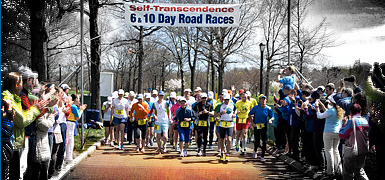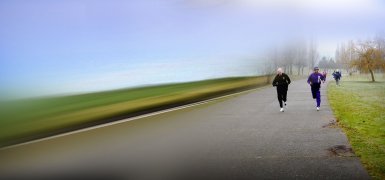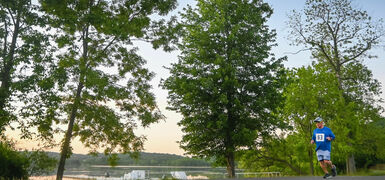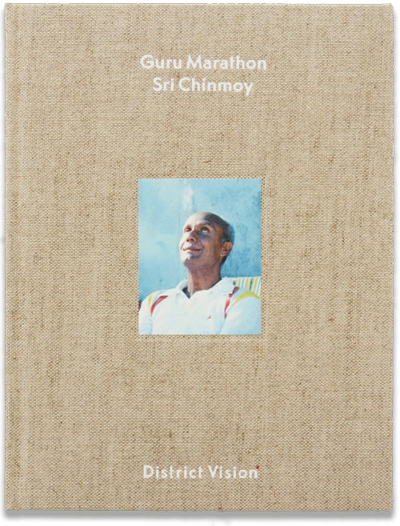Guru ran his fastest marathon on March 25th, 1979 in Toledo, Ohio. It was called the Heartwatcher’s Marathon. Guru’s time was 3:55:07, which is an average pace of 8:58 per mile, or 5:34 per kilometer. He was 47 years old.
This was Guru’s second marathon; his first was just 22 days before in Chico, California at the Bidwell Classic Marathon, where he ran 4:31:34. That race left him hungry for running under four hours; in fact, he explained the day after that he could have run sub-four if it weren’t for muscle cramps late in the race.
On the first day of June the previous year Guru had made the thrilling declaration that “This is the beginning, the golden time,” that he had begun training to run a marathon, and that we should do the same. Previously, there had been only a handful of serious runners among the disciples, and now there were dozens. A couple of years later during some comical banter with a recalcitrant disciple, Guru suggested that each of us had to run a marathon “Otherwise,” he said, “you will not be allowed into Heaven!”
Long distance running was giving Guru tremendous joy, like an old dream of his finally coming true. He had been an athlete his whole life, although he was primarily a sprinter and never liked distance running. Fast-forward to 1985 and we find Guru excelling at another athletic event that he had steadfastly avoided, weightlifting. In both cases, his attitude quickly evolved from conscious avoidance to complete embrace. All of a sudden in 1978, Guru was reading, thinking and talking about distance running, every single day. He was spectating at big races, studying and meeting champion runners, writing poems and songs about running, watching documentary films about famous runners and races, and quizzing disciples about their training.
Guru was also organizing lots of public races, in the New York area and around the world. And he was training sixty to ninety miles per week. During the winter of 1978 Guru did several epic late-night training runs all by himself, upwards of twenty miles each, arriving home at dawn with his entire figure caked with snow and ice.
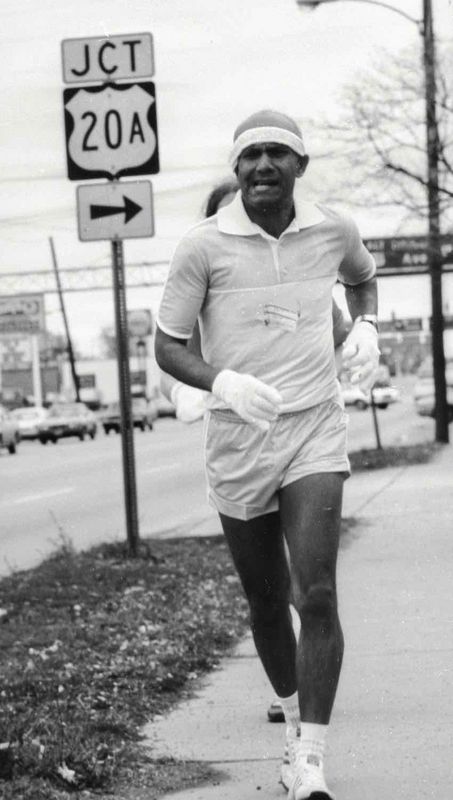
Guru runs past the Wendy's restaurant near mile 16
Guru chose the seventh annual Heartwatcher’s Marathon because it was advertised as being quite flat. This marathon course was point-to-point, starting at the Bowling Green State University Women’s Gymnasium parking lot on Ridge Street and going almost straight north 26.2 miles to the University of Toledo’s Health Education Center on Stadium Drive. Depending on the prevailing winds, the organizers would decide to reverse the course in order to avoid a headwind, but forensic analyses of the photos and movie of Guru’s race reveal that the course was not changed that day. There is an evidential photo of Guru around the 16 mile-mark, near the intersection of Route 20 and Route 20A, across from a Wendy’s fast-food restaurant which still stands as a neighborhood landmark in the city of Maumee. Also, in the movie I’m shouting to Guru late in the race about impending downhill sections of the course, and a topographic study of the region does in fact show a gentle downhill trend there, when running northward.
At that time Guru wanted to run at least one marathon per month, but he didn’t want these races to be hilly. He was bent on achieving his fastest possible time, and hills would obviously impact that. I phoned-up the race director of the Presque Isle Marathon near Erie, Pennsylvania, and drove with Databir to Foxboro, Massachusetts and College Park, Maryland to verify claims of marathon course flatness.
In those days the Heartwatcher’s Marathon was put on by the Toledo Road Runners Club as a fundraiser for the American Heart Association. We discovered it in the events calendar in the back of a Running Times magazine. Those magazines were like gold. We called up the race director and president of the Toledo Roadrunners Club, a certain Mr. Fred Fineske, and he told us that the course was flat as a pancake, so Guru said he would run it. He may have also been charmed by something more subtle about that Midwestern city: indeed, years before he had said “I see light in Toledo.”
The Mayor of the city of Toledo, Douglas Degood, declared March 25th as Sri Chinmoy Day in his city in appreciation of Guru’s marathon run, and the local newspaper, The Blade said “A leading practitioner of meditation will be one of the participants in the marathon. Sri Chinmoy, a native of India, is nationally recognized for his efforts to promote peace through meditation. Sri Chinmoy leads meditations once a week at the United Nations in New York.”
About 40 disciples came to Toledo in a bus that Nishtha organized, and another 20 in cars, driving ten hours through the night from New York to watch Guru run. Unfortunately, the bus got lost and arrived an hour or two after the race started. Also, about 30 disciples drove from Canada. Databir came with me in my new/used 1976 Chevy Malibu Classic station wagon for the 600-mile drive. We arrived in the middle of the night and immediately began searching for the mile-marks, and worked out logistics for meeting Guru along the course during the marathon. That was going to be difficult because, as in many rural areas of the country, some roads will go for over a mile between intersections. And this was long before mobile phones and GPS maps.
It was a small local race, with 152 runners that day, and it was cold -- in the movie of Guru running this race you can see a big clock near the start showing 24 degrees -- and Guru was wearing shorts. It was also windy, and moments of wet snow came and went. Guru later said that at times he ran in between other runners to shield himself from the cold wind. The course had a few small hills and it crossed some major intersections. Parts of the course had considerable traffic, and sometimes a roaring eighteen-wheeler would force you off the road onto the sidewalk.
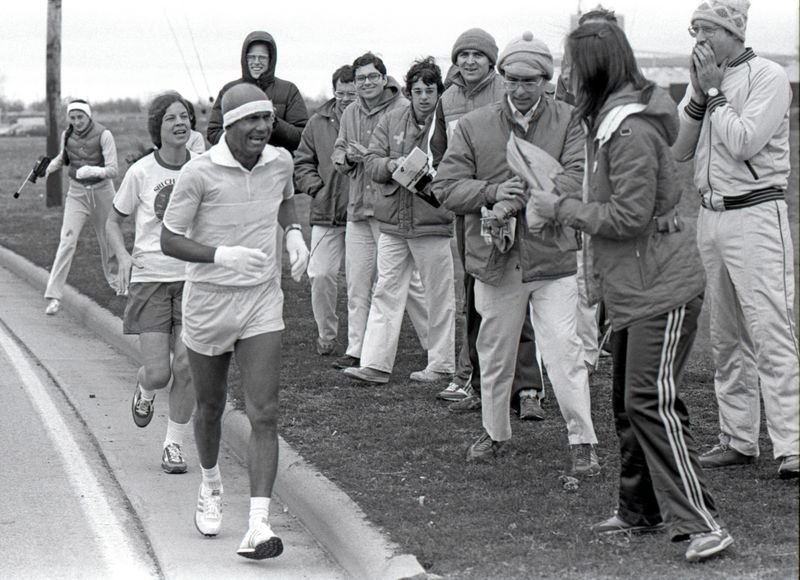
When Guru was approaching a mile marker, we cheered and sang Guru’s running songs as powerfully as we could. Some disciples also played instruments, like oboe. That day we also spontaneously debuted the very motivational “Go, Guru, go!” chant that was used a lot over the next few years. And someone would be holding up a big number sign to show Guru how many miles he had run. Some of these signs were made using paper placemats borrowed from a diner visited en route, as we had forgotten to bring the number signs from New York.
While Guru was running past a mile mark, I would tell him his time for that mile, his average pace and projected finishing time, and also about any hills that might be coming up. Guru told a funny story in Run and Become, Part 8 about how a well-meaning but uninformed disciple was telling Guru their “self-chosen” mile time, a moment before I gave Guru his official time, and the two times were quite different, leading to four or five miles of unfortunate confusion.
After Guru passed a mile mark he got a drink or a hat, and off we went, organized chaos, six or eight to a car, rushing to the next mile mark. To arrive there before Guru did, we had to drive on roads parallel to the course and then abandon our cars and run, sometimes through people’s yards or across frozen cornfields. We must have looked like thieves! For a few minutes we left our cars parked askew in the middle of the road or in someone’s driveway, motors running, heaters blazing and trunk lids open. Savita and other girls were driving my car with drinks and movie camera, so I jumped into whoever’s car was first to leave.
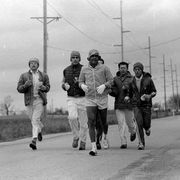
Guru was in great aerobic shape; he could easily talk while he was running, although he preferred to remain silent throughout the race, in a state of yogic concentration and meditation. He had asked a few disciples to run behind him for a mile or two at various points in the race, and I ran with a group of “road crew” boys once or twice. The road crew measured and maintained Guru’s training courses, and attended to all manner of details when Guru ran a race. On this day Guru asked us to run behind him and sing loudly. Most of us were members of the non-singers’ group that Guru called his “immortal singers,” and we sang songs from The Heart-Home of the Immortals, Guru’s recent book of 86 English songs he had composed to his favorite quotes, spoken by famous people over the span of recorded history. In the movie you can hear us trying to sing Virgil’s declaration, “Love Conquers All.”
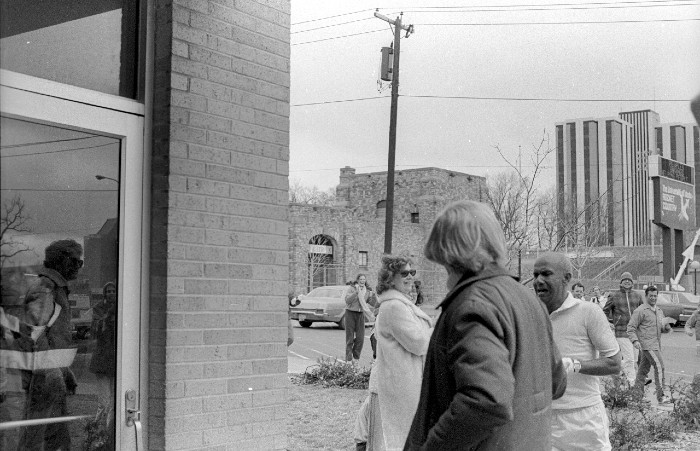
The finish line of the race was kind of unusual, being located inside a university building, and the runners had to run right in the doorway. After Guru finished we crammed into a classroom and tried to get warm; Guru sat wrapped in blankets looking very happy. There was prasad of apples and warm burritos, and someone brought a big cake, and we sang the new “Congratulation” song, and then we went outside for a group picture. At this point in the movie there is a minute or two where image goes out-of-focus, but this somehow helps to convey the dreamy miracle-ness of that day: it felt like Guru had conquered the world and made a solid change to the earth-atmosphere. That evening we had a celebration at the Holiday Inn Hotel where Guru handed out big eight-inch “Marathon” caramel-chocolate Mars Bars to each of us, and the Chicago disciples cooked a 26-course meal for everyone, using the hotel’s big industrial kitchen.
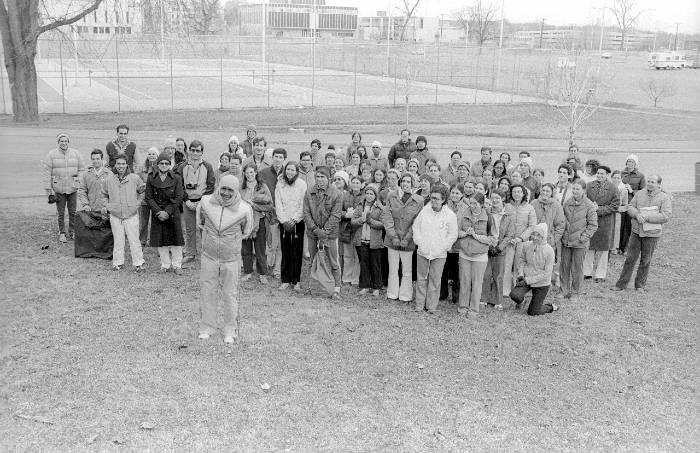
The next day, two dozen newspapers printed articles about Guru’s marathon, including the New York Daily News, which inexplicably announced “A real live Guru crossed the finish line first, setting a new local record” and “Running, he insisted, is good for you. But will it ever replace contemplation? Hmm. Have to meditate on that.”
The Evening Press of Muncie, Indiana ran an article with a picture of Guru and the headline, “Galloping Guru Goes Great Guns.” And the Arizona Daily Sun said about Guru, “The Indian spiritual Master has been bitten by the running bug.”
There are many superb photos of Guru running this marathon, and the original uncut super-8 sound movie remains one of the most important such records we have of Guru.
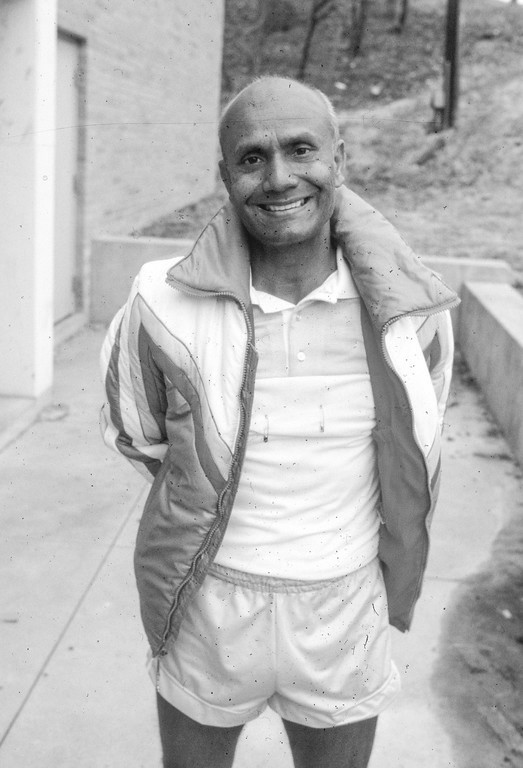
By that August Guru had run two more marathons, and he told Olympic marathoner Gary Fanelli that training twice a day at 80 miles per week had “become quite easy.” Guru said it was his wish to complete five or six 100-mile training weeks before the upcoming New York City Marathon, where he wanted to run under 3:30. The following month Guru did achieve the 100 miles-per-week, and he composed the song “One Hundred Miles.” Altogether in calendar year 1979 Guru completed seven marathons, a 30-mile solo run, a 47-mile race, and six shorter races of three to 13 miles.
Guru completed twenty-two marathon runs over the course of four amazing years, from March 1979 to February 1983, in California, Ohio, New York, New Jersey, New Hampshire and Florida, as well as in Greece, Germany, Switzerland, Puerto Rico and Japan. He said that he is the only spiritual Master who has run a marathon. In 2006 Guru instituted the Sri Chinmoy Invitational Marathon, to be run in New York every April, restricted to only those disciples who have run faster than Guru’s fastest marathon time within the past 10 years. Around 100 disciples ran in the first edition of this race. In 2019 the disciples from the Toledo area organized a Joy Day weekend to celebrate the 40th anniversary of Guru’s fastest marathon. We ran eight miles along the marathon course and had inspiring functions, and now they are planning to make it an annual event. The Heartwatcher’s Marathon is still being held, with a few changes and a new name, now called the “Glass City Marathon,” and they claim it to have one of the 25 fastest courses in the country. They had 1268 finishers last year.
In 2009 when the Russian disciples celebrated the 30th anniversary of Guru’s fastest marathon, they asked me if I was at this marathon with Guru and if I could write something about it. Every year I edit this story; this version is from March 25, 2020. The photos in this article were taken by Bhashwar at this marathon.

